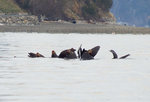

Ask the KP Nature Guide:
Sea Lions “Jugging”
Q: The other day I saw a bunch of sea lions floating with their flippers in the air, just off the beach. They were hardly moving. Were they okay? What were they doing?
— Mimi Chau, Glen Cove
A: These sea lions! They keep trying to trick me. I’ll see a curved fin in the distance and get all excited about an orca — and when I raise my binoculars it’s a sea lion flipper. Only recently did I see my first raft of them behaving in the way you described. From a distance I thought it was a tree with many branches floating in the bay. But no, I counted six to eight sea lions in two groups. They stayed like that for an hour.
The flipper-lifting has to do with heat regulation. Scientists call the behavior “jugging,” following the lead of old-time sealers who called it the jug handle position. California sea lions come to Puget Sound in winter, and while our waters offer plenty of food, it’s a lot colder here than on their Californian and Mexican breeding grounds.
All mammals work hard to maintain a consistent internal temperature. Marine mammals work especially hard: water conducts heat away from the body 25 times faster than air. Sea lions have as adaptations a compact body shape, a thick layer of blubber, and, in their skin and extremities, special cross-linked lacings of veins — so-called retia mirabilia, Latin for “miraculous nets” — that allow heat to pass from outgoing blood to ingoing blood. Still, a sea lion’s flippers are the least insulated parts of its body, and by holding them out of the cold water while it rests, it is able to conserve its precious body heat.
Siskin Invasion
Have you walked under an alder this winter thinking it was empty, only to have its crown explode into a hundred tiny birds? Most likely those were pine siskins, a small finch that travels far and wide in search of seeds. This winter is proving to be exceptional for them — we have a strong cone crop here and food sources farther north are likely limited. Look for siskins at feeders and passing like schools of baitfish above the treetops. Sometimes they’ll flush from roadsides.
You might also see smaller flocks of red crossbills, a finch with a curious bill it uses to pry open conifer cones. They also appear in great numbers in some winters, an event called an irruption. Listen for their strong “kip kip kip” calls.
If you’re extra savvy and look hard, you might even find a rarer arctic finch like a common redpoll or a white-winged crossbill. If you do that, I’ll come sprinting over to have a look.
At the Feeder: Townsend’s Warbler
Unless you feed with suet or mealworms, a Townsend’s warbler is unlikely to pay a visit to your bird feeder. I was lucky enough to be at my mom’s house when this male arrived. While we flipped out — such bright colors ought to be illegal in wintertime — it jumped around to inspect her offerings of seed, moving from perch to perch, even looking into the window as if to ask: “But where’s the good stuff? I’m no vegetarian!”
The first bird to make my jaw drop was a Townsend’s warbler just like the one above. It was just after college, in winter, and with my first real pair of binoculars I was watching a flock of chickadees and kinglets in a cedar when it popped into my field of vision. What!? I yelled. Later that day I ran to the library and began to seriously learn about birds. Needless to say, it was a slippery slope.
Most wood warblers are in Central America this time of year, but a few hardy Townsend’s warblers spend the winter in our evergreens, finding enough insect and spider life to keep them going until spring. Look for them with other small songbirds in tall trees.
Wanted: Mountain Beaver Sightings
It’s the anti-Sasquatch: a creature we all believe doesn’t exist though it actually does. Scientists call it a “living fossil.” I’m looking for locations where mountain beavers thrive on the Key Peninsula. Though they live underground and are seldom seen, their holes – sometimes with piles of food stacked in front – and their habit of gnawing down young raspberry canes and fir trees can give them away. Generally shaped like true beavers, mountain beavers have a stub of a tail, are smaller, and have long fingers and long whiskers.
I’ve heard speculation that they have declined in the area, and I’d like to do some basic research on their local habits and habitats. Did you know that mountain beavers are unable to produce concentrated urine, which forces them to live in places where they can drink over half their weight in water every day? Could this be a relevant fact in a region where summers are getting drier? Only by paying close attention will we gather clues as to how they’re doing. Much about the lives of mountain beavers remains unknown. Email me leads at nature@keypennews.org.
UNDERWRITTEN BY THE FUND FOR NONPROFIT NEWS (NEWSMATCH) AT THE MIAMI FOUNDATION, THE ANGEL GUILD, ADVERTISERS, DONORS AND PEOPLE WHO SUPPORT INDEPENDENT, NONPROFIT LOCAL NEWS